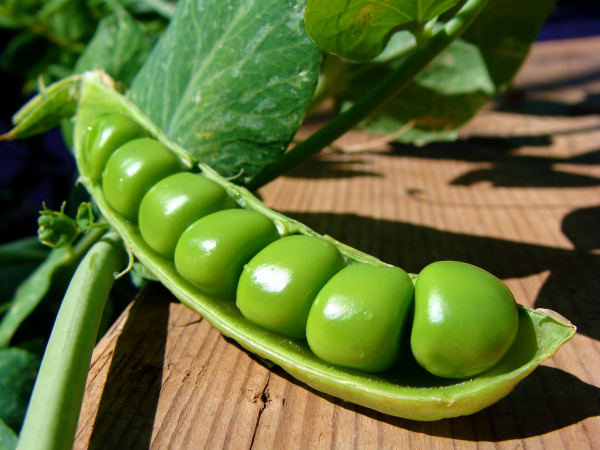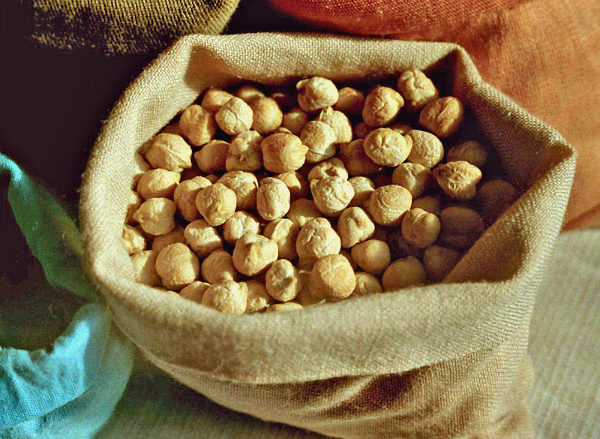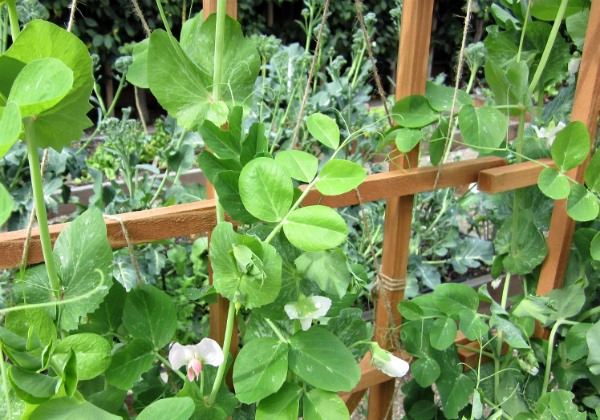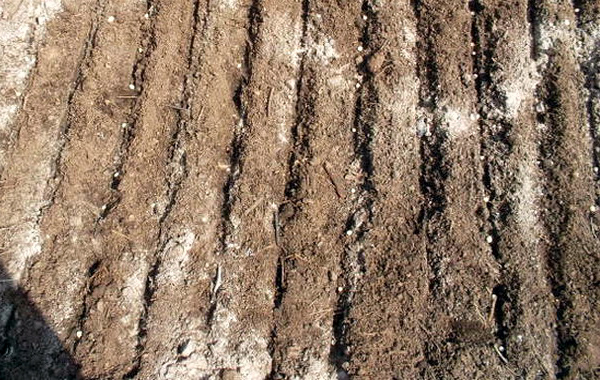How to plant and harvest pea seeds?
Content
About peas
Peas are an annual herb of the legume family with long, lodging shoots. Pea leaves are feathery, with small stipules, ending in several branched tendrils, with the help of which the plant clings to the support and is held vertically. Flowers - white, sometimes purple, placed in the axils of the leaves singly or in small clusters. Pea fruits are bivalve beans with 5–10 spherical, sometimes slightly flattened peas inside.
Peas are one of the very first vegetable crops cultivated by humans for household needs and consumption. It is known that the first cultivated varieties of peas were grown in Ancient Greece, and in Europe they spread thanks to the Dutch, who were the first to introduce and cultivate the plant.
Peas can be called a versatile plant. Its application is diverse: young peas are eaten fresh and canned, dry beans are used as feed for birds, a wide variety of dishes are prepared from them, pea tops can be used as fertilizer - buried in the soil, or added to compost. The plant is an excellent green manure. In the upper part of its root system, small tubers are formed, which contain microorganisms beneficial to plants and soil, in particular nitrogen-fixing bacteria.
Pea varieties are classified into two main groups: vegetable and grain. As a rule, vegetable peas are used for food, which, in turn, are subdivided into the following types:
- shelling;
- cerebral;
- sugar.
Shell peas are intended for the preparation of first and second courses; they are sold dry in stores, but at the beginning of their ripening they have a mild, delicate taste, and during this period they can be eaten fresh.
Brain varieties cannot be dried - they are eaten as greens. Brain peas have a very mild, sweet taste and are canned, frozen, eaten fresh and steamed. Sugar peas practically do not differ in taste from cereal peas and husk peas, but unlike them, its beans are devoid of a dense parchment layer. This nice feature allows such peas to be consumed together with a bean (pod).
Peas of any variety are characterized by a long growing season and high yield potential. The first beans can be removed about 30 days after sowing the seeds, but the process of ripening of peas itself can last up to 70-100 days. This is due to the fact that the ripening of the beans occurs in several stages, starting from the bottom of the bush and ending with the top, the growth of which is not limited.
Even when all the lower beans are harvested, the tops of the stems continue to grow, form new flower stalks and ovaries, and this process can be very long. With proper care, the fruiting period of peas can be extended to 140 days.
Landing
Peas are not grown in seedlings. Its seeds are sown directly into the soil, which is recommended to be prepared in the fall.This is due to the fact that plants do not tolerate fresh fertilizers well, but, despite this, they are in great need of them. Therefore, you need to make top dressing in the fall for digging the beds.
As a fertilizer, you can use ash (50–70 g / sq. M) and compost (4–5 kg / sq. M); in their absence, the soil can be filled with potassium salt and superphosphate. Nitrogen fertilizers need not be applied, since the plant itself accumulates nitrogen compounds.
Before sowing in the ground, the seeds must be prepared. First, a high-quality seed is selected, which will germinate for sure. To do this, there is one effective way: in 1 liter of water you need to dissolve 1 tbsp. a spoonful of salt, then pour all the seeds into this solution. Peas that have surfaced are unsuitable for sowing, and only those that have sunk to the bottom can be planted.
The sorted seed should be rinsed out of salt and dried a little. Next, you need to choose a method of planting seeds. Some gardeners advise soaking the seeds for several hours in room temperature water with the addition of a growth stimulant, after which they need to be rinsed and dried. Others advise sowing seeds dry. Of course, seedlings in this case will appear a little later, but with this technique they will develop faster and become resistant to adverse factors, which will allow you to get a higher yield from future crops.
Before sowing peas, the bed must be loosened, leveled and watered well. The agrotechnology of peas involves band sowing with a distance of 15 cm between furrows. The seeds are buried to a depth of 5–6 cm and laid out in 2 pieces every 8 cm. After that, the peas are covered with earth, slightly compacted. For better germination, the garden bed can be covered with foil. Peas tolerate cold well and germinate at temperatures of 5–8 ° C.
Video "Sowing peas"
This video will show you how to plant green peas in box beds.
Care
Growing peas is not difficult, but some of the features in caring for it must be taken into account:
- Shelter. At first, a bed with peas needs to be covered with a net, but dry unnecessary branches can also be used. In this case, the grid will serve as a shelter for seeds from birds, which are very active in reaching and pecking out peas from the ground.
- Watering mode. Before flowering, the pea bushes are watered once a week. With the appearance of the first peduncles, the frequency and intensity of watering increases up to 2-3 times a week at a water consumption rate of 10 l / 1 sq. m. In this mode, watering is carried out during flowering and the entire period of fruiting (and it can be very long). It is necessary to constantly monitor the moisture content of the soil, since its drying out is fraught with the fall of peduncles and ovaries.
- Loosening. This procedure must be performed after each watering, otherwise a crust may form on the soil, which impedes the growth of the plant and the access to it of nutrients. When the bushes grow up to 15 cm, they need to be spud.
- Support installation. If you do not have standard peas, which are distinguished by stable and non-creeping shoots, but ordinary, curly ones, then it is imperative to install supports or trellises. Otherwise, the stems will cling to everything they reach, and also intertwine with each other. This will lead to the fact that the bed will turn into a solid carpet, and the plants themselves will shade each other, which, of course, will affect the yield.
- Top dressing. During the entire growing season, peas are fed twice: shortly before flowering, and during the period of ovary formation. Peas love micronutrient fertilizers with organic additives, for example, humus, but complex mineral mixtures can also be added. If pests, aphids or pea moths (caterpillars) appear on the plants, it is recommended to spray the bushes with garlic infusion: pour 300 g of crushed garlic with a bucket of water, leave for 10 hours, spray the plants once a week with a solution.
Collection
The first crop of peas can be harvested 30–35 days after sowing.Sugar and brain varieties are used for food when the peas are not yet ripe - it is at this stage that they have a sweet and very delicate taste. In order to prevent overripening, peas should be picked at least once every 2 days.
If the pod has become light and dense, and a white mesh has formed on it, this means that it is overripe, and the peas themselves have become hard and tasteless.
If you do not need to collect peas for seeds, then it is better to remove the overripe pods, since they delay the maturation of the newly formed ovaries. You should pluck the beans from the bush carefully, holding the stems with one hand so as not to be damaged.
If you intend to obtain dry beans for further planting or other purposes, then you must leave the pods on the bush until they are fully ripe. When the lower beans begin to turn brown and dry, the bush is cut at the root, tied into a bunch, which is suspended for 2 weeks in a dry ventilated room or under a canopy for further ripening.
Two weeks later, the heaviest (heaviest) pods are selected, cut with scissors or torn off by hand, after which dried peas are removed from them. You can get the peas by lightly pressing on the bean flaps. Next, you need to select high-quality seeds (deformed and blackened seeds are immediately discarded) and dry them at home.
In general, peas are a very high-yielding crop. Regular abundant watering will help to significantly extend the fruiting period, and ensuring normal conditions and proper care will allow you to harvest up to 5 kg from 1 sq. meter landing.
Video "Collecting peas for seeds"
With this short video, you will see how peas are harvested for seeds.







